plaxis中文参考手册
- 格式:pdf
- 大小:2.58 MB
- 文档页数:162
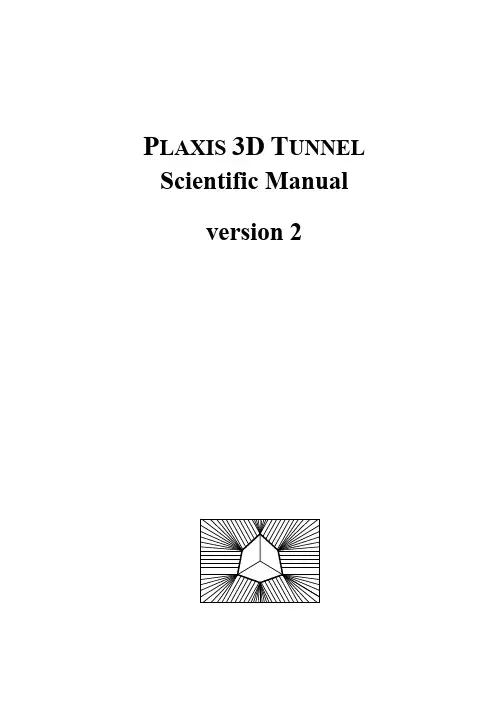
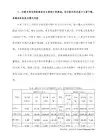
参考手册目录1简介 (7)2 一般说明 (7)2.2 文件处理 (9)2.3 帮助工具 (9)2.4 输入方法 (10)3 输入前处理 (10)3.1 输入程序 (10)3.5 荷载和边界条件 (28)4 材料属性和材料数据组 (33)4.1 模拟土体及界面行为 (35)4.1.1 一般标签页 (35)4.1.2 参数标签页 (39)4.1.3 渗流参数标签页 (50)4.1.4 界面标签页 (56)4.1.5 初始标签页 (61)4.2 不排水行为模拟 (63)4.2.1 不排水(A) (64)4.2.2 不排水(B) (64)4.2.3 不排水(C) (64)4.3 土工试验模拟 (64)4.3.1 三轴试验 (67)4.3.2 固结仪试验 (68)4.3.3 CRS (68)4.3.4 DDS (69)4.3.6 结果 (70)4.4 板的材料数据组 (70)4.4.1 材料数据组 (71)4.4.2 属性 (71)4.5.1 材料数据组 (74)4.5.2 属性 (74)4.6 锚杆的材料数据组 (75)4.6.1 材料数据组 (76)4.6.2 属性 (76)4.7 几何构件的材料数据组赋值 (76)5 计算 (77)5.1 计算程序界面 (77)5.2 计算菜单 (78)5.3 计算模式 (79)5.3.1 经典模式 (80)5.3.2 高级模式 (80)5.3.3 渗流模式 (81)5.4 定义计算阶段 (81)5.4.1 计算标签页 (81)5.4.2 插入或删除计算阶段 (82)5.4.3 计算阶段的标识和顺序 (82)5.5 分析类型 (83)5.5.1 初始应力生成 (83)5.5.2 塑性计算 (85)5.5.3塑性(排水)计算 (85)5.5.4 固结(EPP)分析 (85)5.5.5 固结(TPP)分析 (86)5.5.6 安全性(PHI/C折减) (86)5.5.7 动力分析 (87)5.5.8 自由振动 (87)5.5.9 地下水渗流(稳态) (88)5.5.10 地下水渗流(瞬态) (88)5.5.11 塑性零增长步 (88)5.6 加载步骤 (90)5.6.1 自适应步长法 (90)5.6.2 加载终极水平法 (90)5.6.3 加载步数法 (91)5.6.4 自适应步长(固结) (92)5.7 计算控制参数 (92)5.7.1 迭代过程控制参数 (93)5.7.2 孔压限定 (97)5.7.3 荷载输入 (97)5.7.4 控制参数 (100)5.8 分步施工‐几何定义 (102)5.8.1 改变几何模型 (102)5.8.2 激活或冻结类组或结构对象 (103)5.8.3 激活或改变荷载 (103)5.8.4 应用指定位移 (104)5.8.5 材料数据组重新赋值 (105)5.8.6 在块类组上施加体积应变 (105)5.8.7 施加锚杆预应力 (106)5.8.8 施加隧道衬砌收缩 (106)5.8.9 ΣMstage < 1 的分步施工 (107)5.8.10 未完成的分步施工计算 (108)5.9 分步施工‐水力条件 (109)5.9.1 水的单位重度 (109)5.9.2 潜水位 (109)5.9.3 封闭边界 (113)5.9.4 降水 (113)5.9.5 类组水位分布 (114)5.9.6 渗流和固结边界条件 (115)5.9.7 特殊对象 (115)5.10 荷载乘子 (115)5.10.1 标准荷载乘子 (116)5.10.2 其它乘子和计算参数 (118)5.10.3 动力乘子 (119)5.11敏感性分析&参数变化 (120)5.11.1敏感性分析 (121)5.11.2参数变化 (121)5.11.3定义参数变化 (121)5.11.5 敏感度—查看结果 (123)5.11.6 参数变化 — 计算边界值 (125)5.11.7 查看上下限 (125)5.11.8 查看变化结果 (125)5.11.9 删除结果 (126)5.12 执行计算 (126)5.12.1 预览施工阶段 (126)5.12.2 选定曲线点 (126)5.12.3 执行计算过程 (126)5.12.4 放弃计算 (127)5.12.5 计算过程中输出 (127)5.12.6 选择拟输出计算阶段 (130)5.12.7 重置分步施工设置 (130)5.12.8 计算过程中调整输入数据 (131)5.12.9 自动误差检验 (131)6 输出程序‐概览 (133)6.1 输出程序的界面 (134)6.2 菜单栏中的菜单 (135)6.3 输出程序中的工具 (138)6.4绘图区 (144)6.5 输出的视图 (147)6.6报告生成 (148)6.7生成动画 (151)7 输出程序中的可用结果 (152)8曲线 (161)1简介PLAXIS 2D是一个专门用于各种岩土工程问题中变形和稳定性分析的二维有限元计算程序。
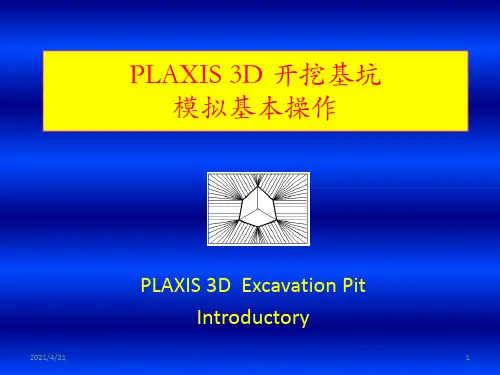
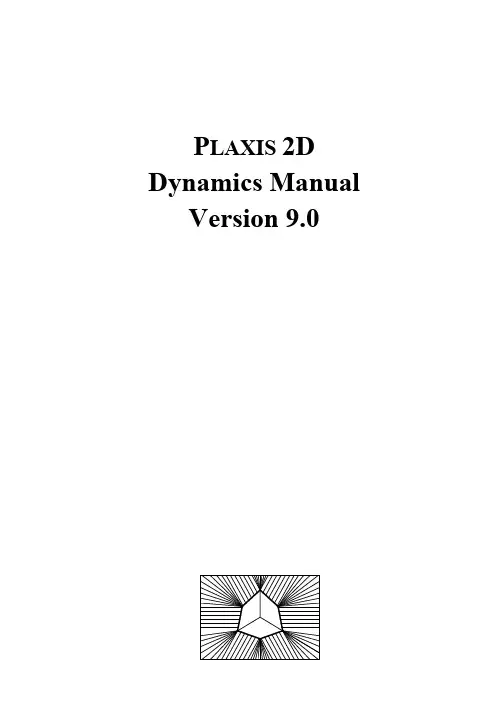
P LAXIS 2D Dynamics Manual Version 9.0TABLE OF CONTENTS TABLE OF CONTENTS1Introduction..................................................................................................1-11.1About this manual..................................................................................1-11.2Dynamic loading features......................................................................1-2 2Tutorial.........................................................................................................2-12.1Dynamic analysis of a generator on an elastic foundation.....................2-12.1.1Input...........................................................................................2-12.1.2Initial conditions........................................................................2-42.1.3Calculations................................................................................2-52.1.4Output........................................................................................2-72.2Pile driving.............................................................................................2-92.2.1Initial conditions......................................................................2-122.2.2Calculations..............................................................................2-122.2.3Output......................................................................................2-142.3Building subjected to an earthquake....................................................2-152.3.1Initial conditions......................................................................2-172.3.2Calculations..............................................................................2-172.3.3Output......................................................................................2-19 3Reference......................................................................................................3-13.1Input.......................................................................................................3-13.1.1General settings..........................................................................3-23.1.2Loads and Boundary conditions.................................................3-33.1.3Absorbent boundaries................................................................3-33.1.4External loads and Prescribed displacements.............................3-33.1.5Model parameters.......................................................................3-53.2Calculations...........................................................................................3-83.2.1Selecting dynamic analysis........................................................3-83.2.2Dynamic analysis parameters.....................................................3-83.2.3Iterative procedure manual setting.............................................3-93.2.4Dynamic loads.........................................................................3-113.2.5Activating Dynamic loads........................................................3-113.2.6Harmonic loads........................................................................3-123.2.7Load multiplier time series from data file................................3-133.2.8Modelling block loads..............................................................3-153.3Output..................................................................................................3-153.4Curves..................................................................................................3-16 4Validation and verification of the dynamic module..................................4-14.1One-dimensional wave propagation.......................................................4-14.2Simply supported beam..........................................................................4-34.3Determination of the velocity of the Rayleigh wave..............................4-5iDYNAMICS MANUAL4.4Lamb’s problem.....................................................................................4-74.5Surface waves: Comparison with boundary elements.........................4-114.6Pulse load on a multi layer system.......................................................4-12 5Theory...........................................................................................................5-15.1Basic equation dynamic behaviour........................................................5-15.2Time integration....................................................................................5-25.2.1Wave velocities..........................................................................5-35.2.2Critical time step........................................................................5-45.3Model boundaries..................................................................................5-45.3.1Absorbent boundaries................................................................5-55.4Initial stresses and stress increments......................................................5-6 6References....................................................................................................6-1ii P LAXIS 2DINTRODUCTION 1INTRODUCTIONSoil and structures are often subjected not only to static loads due to constructions in and on the ground surface but also to dynamic loads. If the loads are powerful, as in earthquakes, they may cause severe damages. With the P LAXIS Dynamic analysis module you can analyse the effects of vibrations in the soil.Vibrations may occur either manmade or natural. In urban areas, vibrations can be generated due to pile driving, vehicle movement, heavy machinery and/or train travel. A natural source of vibrations in the subsoil is earthquakes.The effects of vibrations have to be calculated with a dynamic analysis when the frequency of the dynamic load is in the order or higher than the natural frequency of the medium. Low frequency vibrations can be calculated with a pseudo-static analysis.In modelling the dynamic response of a soil structure, the inertia of the subsoil and the time dependence of the load are considered. Also, damping due to material and/or geometry is taken into account. Initially the Linear-elastic model can be utilised for the simulation of the dynamic effects, but in principle any of the available soil models in P LAXIS can be used.Excess pore pressures can be included in the analysis if undrained soil behaviour is assumed. Liquefaction, however, is not considered in P LAXIS 2D. Future versions may incorporate a model that is able to simulate this phenomenon.Even though vibrations often have 3D-characteristics, in P LAXIS 2D, the dynamic model is limited to plane strain and axisymmetric conditions.The dynamic calculation program was developed in cooperation with the University of Joseph Fourier in Grenoble. This cooperation is gratefully acknowledged.1.1ABOUT THIS MANUALThis manual will help the user to understand and work with the P LAXIS Dynamics module. New users of P LAXIS are referred to the Tutorial Manual first (P LAXIS 2D). Tutorial ChaptersThe Dynamics manual starts with a tutorial section. The user is advised to work through the exercises. In the first exercise the influence of a vibrating source over its surrounding soil is studied. The second exercise deals with the effects of pile driving. The third exercise analyse the effect of an earthquake on a five-storey building.Reference ChaptersThe second part of the Dynamics manual consists of four chapters. These chapters describe the four parts of the P LAXIS Program (input, calculation, output and curves) in view of the functionality of the Dynamics module.1-1DYNAMICS MANUALValidation/Verification ChaptersThe third part of the manual describes some of the test cases that were used to validate the accuracy and performance of the dynamics module.Theory ChaptersIn the fourth part of the manual you will find a brief review of the theoretical aspects of the dynamic model as used and implemented in P LAXIS.1.2DYNAMIC LOADING FEATURESThe way dynamic loads in P LAXIS are applied during calculations is similar but not exactly equal to version 7 and older. The creation and generation of dynamic loads is summarized below:1.In the Input program:•create loads such as load system A or B and/or prescribed displacements.•set the appropriate load (load system A, B and/or prescribed displacements) asa dynamic load using the Loads menu2.In the Calculation program:•activate dynamic loads using the dynamic load Multipliers input window in the Multipliers tab sheet. An active button will appear for each load.Unlike the way static loads are defined (using Staged construction) dynamic loads are defined by means of the dynamic Multipliers. These Multipliers operate as scaling factors on the input values of the dynamic loads (as entered in the Input program) to produce the actual load magnitudes. If a particular load system is set as a dynamic load, the load is initially kept active, but the corresponding load multiplier is set to zero in the Input program. In the Calculation program, it is specified how the (dynamic) load multiplier changes with time rather the input value of the load. The time dependent variation of the load multiplier acts on all loads in the corresponding load system.1-2 P LAXIS 2DTUTORIAL 2TUTORIALThis tutorial is intended to help users to become familiar with the features of the P LAXIS dynamics module. New users of P LAXIS are referred to the Tutorial Manual of the complete P LAXIS 2D manual first. The lessons in this part of the Dynamics manual deal with three specific dynamic applications of the program.Generator on elastic foundation•an axisymmetric model for single source vibrations•dynamic soil-structure interaction•standard absorbent boundariesPile driving•plastic behaviour•influence of waterBuilding subjected to an earthquake• a plane strain analysis for earthquake problems•SMC file used for acceleration input•standard earthquake boundaries2.1DYNAMIC ANALYSIS OF A GENERATOR ON AN ELASTICFOUNDATIONUsing P LAXIS,it is possible to simulate soil-structure interaction. Here the influence of a vibrating source on its surrounding soil is studied.Due to the three dimensional nature of the problem, an axisymmetric model is used. The physical damping due to the viscous effects is taken into consideration via the Rayleigh damping. Also, due to axisymmetry 'geometric damping' can be significant in attenuating the vibration.The modelling of the boundaries is one of the key points. In order to avoid spurious wave reflections at the model boundaries (which do not exist in reality), special conditions have to be applied in order to absorb waves reaching the boundaries.2.1.1INPUTThe vibrating source is a generator founded on a 0.2 m thick concrete footing of 1 m in diameter, see Figure 2.1. Oscillations caused by the generator are transmitted through the footing into the subsoil. These oscillations are simulated as a uniform harmonic loading, with a frequency of 10 Hz and amplitude of 10 kN/m2. In addition to the weight2-1DYNAMICS MANUALof the footing, the weight of the generator is assumed 8 kN/m2, modelled as a uniformly distributed load.Figure 2.1 Generator founded on elastic subsoil.Geometry modelThe problem is simulated using an axisymmetric model with 15-noded elements. The geometry model is shown in Figure 2.2. Use [s] (seconds) as the unit of time, since dynamic effects are usually in the order of seconds rather than days.The model boundaries should be sufficiently far from the region of interest, to avoid disturbances due to possible reflections. Although special measures are adopted in order to avoid spurious reflections (absorbent boundaries), there is always a small influence and it is still a good habit to put boundaries far away. In a dynamic analysis, model boundaries are generally taken further away than in a static analysis.To set up the problem geometry, the following steps are necessary:•Enter the geometry model as shown in Figure 2.2.•Use plate elements to model the footing.•Use Standard fixities.•Apply a distributed load (system A) on the footing to model the weight of the generator.•Apply a distributed load (system B) on the footing to model the dynamic load.•In the Loads menu, set the Dynamic load system to load system B.Absorbent boundariesSpecial boundary conditions have to be defined to account for the fact that in reality the soil is a semi-infinite medium. Without these special boundary conditions the waves would be reflected on the model boundaries, causing perturbations. To avoid these spurious reflections, absorbent boundaries are specified at the bottom and right hand side boundary.2-2 P LAXIS 2DTUTORIAL 2-3To add the absorbent boundaries you can use the Standard absorbent boundaries optionin the Loads menu. If necessary, the absorbent boundaries can be generated manually as:1. Select the menu option Absorbent boundaries in the Loads menu.2. Click on the lower left point of the geometry,3. Proceed to the lower right point and click again,4. Proceed to the upper right point and click again.Only the right and bottom boundaries are absorbent boundaries. The left boundary is anaxis of symmetry and the upper boundary is a free surface.Figure 2.2 Generator model with absorbent boundariesMaterial propertiesThe properties of the subsoil are given in Table 2.1. It consists of sandy clay, which isassumed to be elastic. The Young’s modulus in Table 2.1 seems relatively high. This isbecause the dynamic stiffness of the ground is generally considerably larger than thestatic stiffness, since dynamic loadings are usually fast and cause very small strains. Theunit weight suggests that the soil is saturated; however the presence of the groundwateris neglected. The footing has a weight of 5 kN/m 2 and is also assumed to be elastic. Theproperties are listed in Table 2.2.Table 2.1 Material properties of the subsoil Parameter Name Value Unit Material model Model Elastic -Type of material behaviour Type Drained -Unit weight γ20.0 kN/m 3 Young's modulus (constant) E ref 50000 kN/m 2Poisson's ratio ν0.3 -DYNAMICS MANUAL2-4 P LAXIS 2D Table 2.2 Material properties of the footing Parameter Name Value Unit Normal stiffness EA 7.6 · 106 kN/m Flexural rigidity EI 24000 kNm 2/mWeight W 5.0 kN/m/mPoisson's ratio ν0.0 - Hint: When using Mohr-Coulomb or linear elastic models the wave velocities V pand V s are calculated from the elastic parameters and the soil weight. V p andV s can also be entered as input; the elastic parameters are then calculatedautomatically. See also Elastic parameters in Section 3.1.5 and the WaveVelocity relationships in Section 5.2.1.Mesh generationBecause of the expected high concentration of stresses in the area below the footing, alocal refinement is proposed there. The mesh is generated with the global coarseness setto ‘coarse’ and then the line of the footing is refined two times. The result is plotted inFigure 2.3.Figure 2.3 Geometry and mesh2.1.2 INITIAL CONDITIONSWater pressures:Since water is not considered in this example, the generation of water pressures can beskipped.Initial stresses:The initial stresses are generated by means of the K0 procedure , using a K 0 value of 0.5.In the initial situation, the footing and the static load do not exist and therefore they aredeactivated. The dynamic load seems active but the corresponding multiplier isautomatically set to zero.2.1.3CALCULATIONSThere are three calculation phases. In the first phase the footing is built and the static load (weight of the generator) is applied. The second phase is the situation when the generator is running. In the third phase the generator is turned off and the soil is let to vibrate freely. The last two phases involve dynamic calculations.Phase 1:1.Select Plastic calculation in the General tab sheet.2.Select Staged construction in the Parameter tab sheet and click on the Definebutton3.Click on the plate element and select all objects from the Select items window. Byusing the Change option, set the static load (system A) to 8 kN/m2. Note that this value can also be set in the Input program (see the Reference Manual).Phase 2:In this phase, a vertical harmonic load, with a frequency of 10 Hz and amplitude of 10 kN/m2, is applied to simulate the vibrations transmitted by the generator. Five cycles with a time interval of 0.5 sec are considered.1.Select Dynamic analysis in the General tab sheet.e 100 for the number of Additional steps, reset displacement to zero and set Timeinterval to 0.5 s.3.Select Total multipliers and click on the Define button.4.Click on (next to ΣMloadB in the Multipliers tab sheet) to proceed with thedefinition of the dynamic load.5.Click the option Harmonic load multiplier in the window Dynamic loading-LoadSystem B.6.Set the Amplitude multiplier to 10, frequency to 10 Hz and Initial phase angle to 0(See Figure 2.4).Figure 2.4 Harmonic loadPhase 3:In this phase, the generator is turned off. The soil is vibrating freely after the initial excitation.1.Select Dynamic analysis in the General tab sheet.e 100 for the number of Additional steps.3.Set Time interval to 0.5 s. The estimated end time is 1 sec.4.Select Total multipliers and click on the Define button.5.Click on next to ΣMloadB in the Multipliers tab sheet. Set all parameters tozero in the Dynamic loading window.Before running the calculation, select points at the surface at about 1.4m, 1.9m and 3.6m. They will be used by the Curves program to visualise the deformation as a function of time. You can now start the calculation.Additional calculation with damping:In a second calculation, material damping is introduced by means of Rayleigh damping. Rayleigh damping can be entered in the material data set. The following steps are necessary:1.Start the Input program and select the generator project.2.Save the project under another name.3.Open the material data set of the soil. In the General tab sheet click on theAdvanced button.4.Change the Rayleigh damping parameters α and β to 0.001 and 0.01 respectively(Figure 2.5).Figure 2.5 Input of Rayleigh damping5.Close the data base, proceed to Initial conditions and save the project.6. In the Calculations program, check whether the phases are still properly defined(according to the information given before) and start the calculation.2.1.4 OUTPUTThe Curves program is particularly useful for dynamic analysis. You can easily displaythe actual loading versus time (input) and also displacements, velocities andaccelerations of the pre-selected points versus time. Figure 2.6 shows the evolution ofthe applied load with time, as defined by the calculation phases 2 and 3.-10-55D i i []Load system BFigure 2.6 Load – time curve0.0Time [s]Displacement [m]Figure 2.7 Displ.- time on the surface at different distances to the vibrating source.Without damping (Rayleigh α = 0; β = 0).Figure 2.7 shows the response of the pre-selected points at the surface of the structure. Itcan be seen that even with no damping, the waves are dissipated which can be attributedto the geometric damping.0.0Time [s]Figure 2.8 Displ.- time. With damping (Rayleigh α = 0.001 ; β = 0.01).The presence of damping is clear in Figure 2.8. It can be seen that the vibration is totallyseized after the removal of the force (after t = 0.5 s). Also, the displacement amplitudesare lower. Compare Figure 2.7 (without damping) with Figure 2.8 (with damping).Figure 2.9 Total accelerations in the soil at the end of phase 2 (with damping).It is possible in the Output program to display displacements, velocities and accelerations at a particular time, by choosing the appropriate option in the Deformations menu. Figure 2.9 shows the total accelerations in the soil at the end of phase 2 (t = 0.5 s).2.2PILE DRIVINGThis example involves driving a concrete pile through an 11 m thick clay layer into a sand layer, see Figure 2.10. The pile has a diameter of 0.4 m. Pile driving is a dynamic process that causes vibrations in the surrounding soil. Moreover, excess pore pressures are generated due to the quick stress increase around the pile.In this example focus is placed on the irreversible deformations below the pile. In order to simulate this process most realistically, the behaviour of the sand layer is modelled by means of the Hardening Soil model.Figure 2.10 Pile driving situationGeometry modelThe geometry is simulated by means of an axisymmetric model in which the pile is positioned along the axis of symmetry (see Figure 2.11). In the general settings, the standard gravity acceleration is used (9.8 m/s2). The unit of time should be set to seconds [s].Both the soil and the pile are modelled with 15-noded elements. The subsoil is divided into an 11 m thick clay layer and a 7 m thick sand layer. Interface elements are placed around the pile to model the interaction between the pile and the soil. The interface should be extended to about half a meter into the sand layer (see Figure 2.12). A proper modelling of the pile-soil interaction is important to include the material dampingcaused by the sliding of the soil along the pile during penetration and to allow forsufficient flexibility around the pile tip. Use the zoom option to create the pile and theinterface.Figure 2.11 Geometry model of pile driving problemThe boundaries of the model are taken sufficiently far away to avoid direct influence ofthe boundary conditions. Standard absorbent boundaries are used at the bottom and atthe right hand boundary to avoid spurious reflections. Hint: When boundary conditions are applied using the Standard fixities button,horizontal fixities are also applied to the pile top. The standard fixities optionassigns fixities to all lines that lie witin certain limits from the boundaries ofthe geometry and as, due to its dimensions, the pile top falls within theselimits, boundary conditions are applied. Since this is not desired make sure toremove the horizontal fixities at the pile top.In order to model the driving force, a distributed unit load (system A) is created on topof the pile. From the Loads menu set Load system Aas a dynamic load system.(0.0, 7.0)Figure 2.12 Extended InterfaceMaterial propertiesThe clay layer is modelled with the Mohr-Coulomb model. The behaviour is consideredto be undrained. An interface strength reduction factor is used to simulate the reduced friction along the pile shaft.In order to model the non-linear deformations below the tip of the pile in a right way,the sand layer is modelled by means of the Hardening Soil model. Because of the fastloading process, the sand layer is also considered to behave undrained. The short interface in the sand layer does not represent soil-structure interaction. As a result, theinterface strength reduction factor should be taken equal to unity (rigid).The pile is made of concrete, which is modelled by means of the linear elastic model considering non-porous behaviour. In the beginning, the pile is not present, so initiallythe clay properties are also assigned to the pile cluster. The parameters of the two layersand the concrete pile are listed in Table 2.3.Table 2.3 Material properties of the subsoil and pileParameter Symbol Clay Sand Pile Unit Material model Model Mohr-C. Hardening-S Linear elast. -Type of behaviour Type Undrained Undrained Non-porous -Unit weight aboveγunsat16 17 24 kN/m3 phreatic lineUnit weight below18 20 - kN/m3 phreatic line γsatYoung's modulus E ref15000 50000 3·107 kN/m2Oedometer modulus E oed- 50000 - kN/m2 Power m - 0.5 - -- kN/m2 Unloading modulus E ur- 150000Poisson's ratio ν0.3 0.2 0.1 - Reference stress P ref- 100 - kN/m2 Cohesion c 2 1 - kN/m2 Friction angle ϕ24 31 - °Dilatancy angle ψ0 0 - °Interface strengthR inter0.5 1.0 (rigid) 1.0 (rigid) - reductionIt should be noted that there is a remarkable difference in wave velocities between the clay layer and the concrete pile due to the large stiffness difference. This may lead to small time increments (many sub steps) in the automatic time stepping procedure. This causes the calculation process to be very time consuming. Many sub steps may also be caused by a very small (local) element size. In such situations it is not always vital to follow the automatic time stepping criterion. You can reduce the number of sub steps inthe Manual setting of the Iterative procedure (Section 3.2.3).When the Hardening Soil model is used wave velocities are not shown because they vary due to the stress-dependent stiffness.Mesh generationThe mesh is generated with a global coarseness set to coarse (default). A local refinement is made in the pile cluster. The result of the mesh generation is plotted in Figure 2.13.18yFigure 2.13 Finite element mesh for pile driving problem.2.2.1INITIAL CONDITIONSWater pressures:The phreatic level is assumed to be at the ground surface. Hydrostatic pore pressures are generated in the whole geometry according to this phreatic line.Initial stresses:Initial effective stresses are generated by the K0procedure, using the default values. Note that in the initial situation the pile does not exist and that the clay properties should be assigned to the corresponding clusters.2.2.2CALCULATIONSThe analysis consists of three calculation phases. In the first phase the pile is created. In the second phase the pile is subjected to a single stroke, which is simulated by activating half a harmonic cycle of load system A. In the third phase the load is kept zero and the dynamic response of the pile and soil is analysed in time. The last two phases involve dynamic calculations.Phase 1:1.Select Plastic calculation in the General tab sheet.2.Select Staged construction in the Parameter tab sheet.3.Assign the pile properties to the pile cluster.Phase 2:1.Select Dynamic analysis in the General tab sheet.e standard Additional steps (250).3.Reset displacements to zero.4.Enter 0.01 s for the Time interval.5.Select Manual setting for the iterative procedure and click Define. The initialnumber of Dynamic sub steps is relatively large, due to the large difference in wave speeds and the small element sizes (see earlier remark on material properties). Set the number of Dynamic sub steps to 1. All other settings remain at their default. 6.Click next to Load system A in the Multiplier tab sheet to apply the dynamicloading. Enter the values as indicated in Figure 2.14.Figure 2.14 Dynamic loading parametersThe result of this phase is half a harmonic cycle of the external load in system A. At the end of this phase, the load is back to zero.Phase 3:1.Select Dynamic analysis in the General tab sheet.e standard Additional steps (250).3.Enter a Time interval of 0.19 s.4.Select the Manual setting for the Iterative procedure and click Define. Set thenumber of Dynamic sub steps to 19. This results in equal time steps in phase 2 and3.5.In the Multiplier tab sheet, all multipliers remain at their default values.6.Click next to Load system A and set all parameters in the Dynamic Loadingwindow to zero.。
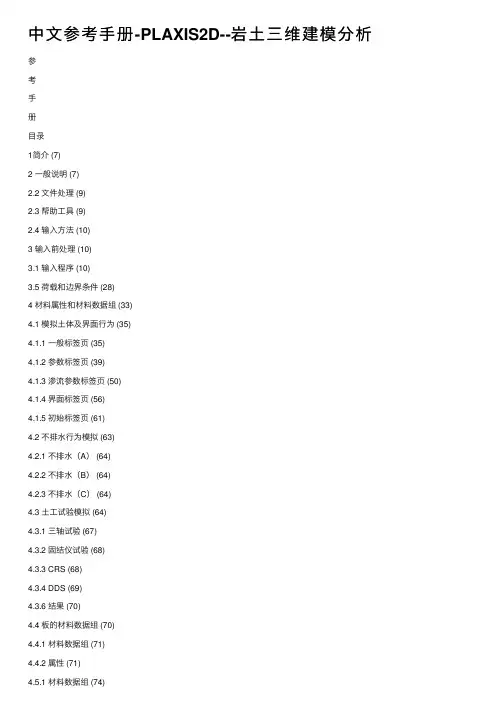
中⽂参考⼿册-PLAXIS2D--岩⼟三维建模分析参考⼿册⽬录1简介 (7)2 ⼀般说明 (7)2.2 ⽂件处理 (9)2.3 帮助⼯具 (9)2.4 输⼊⽅法 (10)3 输⼊前处理 (10)3.1 输⼊程序 (10)3.5 荷载和边界条件 (28)4 材料属性和材料数据组 (33)4.1 模拟⼟体及界⾯⾏为 (35)4.1.1 ⼀般标签页 (35)4.1.2 参数标签页 (39)4.1.3 渗流参数标签页 (50)4.1.4 界⾯标签页 (56)4.1.5 初始标签页 (61)4.2 不排⽔⾏为模拟 (63)4.2.1 不排⽔(A) (64)4.2.2 不排⽔(B) (64)4.2.3 不排⽔(C) (64)4.3 ⼟⼯试验模拟 (64)4.3.1 三轴试验 (67)4.3.2 固结仪试验 (68)4.3.3 CRS (68)4.3.4 DDS (69)4.3.6 结果 (70)4.4 板的材料数据组 (70)4.4.1 材料数据组 (71)4.4.2 属性 (71)4.5.1 材料数据组 (74)4.5.2 属性 (74)4.6 锚杆的材料数据组 (75)4.6.1 材料数据组 (76)4.6.2 属性 (76)4.7 ⼏何构件的材料数据组赋值 (76)5 计算 (77)5.1 计算程序界⾯ (77)5.2 计算菜单 (78)5.3 计算模式 (79)5.3.1 经典模式 (80)5.3.2 ⾼级模式 (80)5.3.3 渗流模式 (81)5.4 定义计算阶段 (81)5.4.1 计算标签页 (81)5.4.2 插⼊或删除计算阶段 (82)5.4.3 计算阶段的标识和顺序 (82) 5.5 分析类型 (83)5.5.1 初始应⼒⽣成 (83)5.5.2 塑性计算 (85)5.5.3塑性(排⽔)计算 (85)5.5.4 固结(EPP)分析 (85)5.5.5 固结(TPP)分析 (86)5.5.6 安全性(PHI/C折减) (86) 5.5.7 动⼒分析 (87)5.5.8 ⾃由振动 (87)5.5.9 地下⽔渗流(稳态) (88)5.5.10 地下⽔渗流(瞬态) (88) 5.5.11 塑性零增长步 (88)5.6 加载步骤 (90)5.6.1 ⾃适应步长法 (90)5.6.2 加载终极⽔平法 (90)5.6.3 加载步数法 (91)5.6.4 ⾃适应步长(固结) (92)5.7 计算控制参数 (92)5.7.1 迭代过程控制参数 (93)5.7.2 孔压限定 (97)5.7.3 荷载输⼊ (97)5.7.4 控制参数 (100)5.8 分步施⼯‐⼏何定义 (102)5.8.1 改变⼏何模型 (102)5.8.2 激活或冻结类组或结构对象 (103) 5.8.3 激活或改变荷载 (103)5.8.4 应⽤指定位移 (104)5.8.5 材料数据组重新赋值 (105)5.8.6 在块类组上施加体积应变 (105) 5.8.7 施加锚杆预应⼒ (106)5.8.8 施加隧道衬砌收缩 (106)5.8.9 ΣMstage < 1 的分步施⼯ (107) 5.8.10 未完成的分步施⼯计算 (108) 5.9 分步施⼯‐⽔⼒条件 (109)5.9.1 ⽔的单位重度 (109)5.9.2 潜⽔位 (109)5.9.3 封闭边界 (113)5.9.4 降⽔ (113)5.9.5 类组⽔位分布 (114)5.9.6 渗流和固结边界条件 (115)5.9.7 特殊对象 (115)5.10 荷载乘⼦ (115)5.10.1 标准荷载乘⼦ (116)5.10.2 其它乘⼦和计算参数 (118)5.10.3 动⼒乘⼦ (119)5.11敏感性分析&参数变化 (120)5.11.1敏感性分析 (121)5.11.2参数变化 (121)5.11.3定义参数变化 (121)5.11.5 敏感度—查看结果 (123)5.11.6 参数变化 — 计算边界值 (125) 5.11.7 查看上下限 (125)5.11.8 查看变化结果 (125)5.11.9 删除结果 (126)5.12 执⾏计算 (126)5.12.1 预览施⼯阶段 (126)5.12.2 选定曲线点 (126)5.12.3 执⾏计算过程 (126)5.12.4 放弃计算 (127)5.12.5 计算过程中输出 (127)5.12.6 选择拟输出计算阶段 (130)5.12.7 重置分步施⼯设置 (130)5.12.8 计算过程中调整输⼊数据 (131)5.12.9 ⾃动误差检验 (131)6 输出程序‐概览 (133)6.1 输出程序的界⾯ (134)6.2 菜单栏中的菜单 (135)6.3 输出程序中的⼯具 (138)6.4绘图区 (144)6.5 输出的视图 (147)6.6报告⽣成 (148)6.7⽣成动画 (151)7 输出程序中的可⽤结果 (152)8曲线 (161)1简介PLAXIS 2D是⼀个专门⽤于各种岩⼟⼯程问题中变形和稳定性分析的⼆维有限元计算程序。
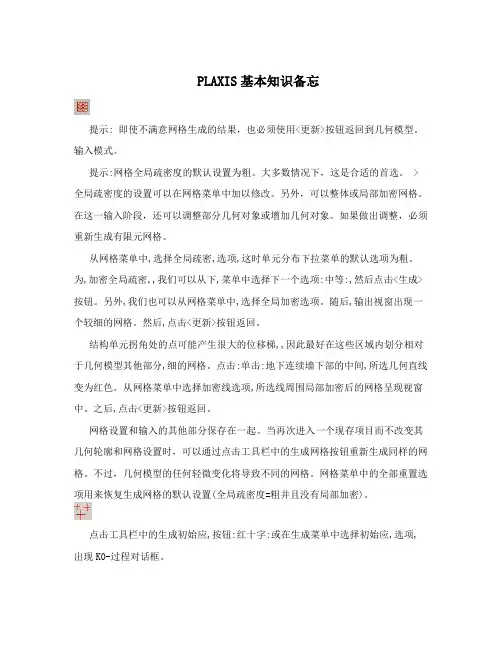
PLAXIS基本知识备忘提示: 即使不满意网格生成的结果,也必须使用<更新>按钮返回到几何模型。
输入模式。
提示:网格全局疏密度的默认设置为粗。
大多数情况下,这是合适的首选。
> 全局疏密度的设置可以在网格菜单中加以修改。
另外,可以整体或局部加密网格。
在这一输入阶段,还可以调整部分几何对象或增加几何对象。
如果做出调整,必须重新生成有限元网格。
从网格菜单中,选择全局疏密,选项,这时单元分布下拉菜单的默认选项为粗。
为,加密全局疏密,,我们可以从下,菜单中选择下一个选项:中等:,然后点击<生成>按钮。
另外,我们也可以从网格菜单中,选择全局加密选项。
随后,输出视窗出现一个较细的网格。
然后,点击<更新>按钮返回。
结构单元拐角处的点可能产生很大的位移梯,,因此最好在这些区域内划分相对于几何模型其他部分,细的网格。
点击:单击:地下连续墙下部的中间,所选几何直线变为红色。
从网格菜单中选择加密线选项,所选线周围局部加密后的网格呈现视窗中。
之后,点击<更新>按钮返回。
网格设置和输入的其他部分保存在一起。
当再次进入一个现存项目而不改变其几何轮廓和网格设置时,可以通过点击工具栏中的生成网格按钮重新生成同样的网格。
不过,几何模型的任何轻微变化将导致不同的网格。
网格菜单中的全部重置选项用来恢复生成网格的默认设置(全局疏密度=粗并且没有局部加密)。
点击工具栏中的生成初始应,按钮:红十字:或在生成菜单中选择初始应,选项,出现K0-过程对话框。
保持土体容重的总乘子:ΣMweight,等于1.0_这意味着土的全部重,应用于生成初始应,。
接受PLAXIS 建议的K0 默认值并点击<确认>按钮。
提示:K0-过程只能应用于地基水平分层且表面水平,地下水位也是水平的情况。
关于K0-过程的详细知识,参见附录A 或参考手册。
K0 的默认值基于Jaky 公式:K0,1-sinφ。
修改默认值以后,输入一个负值可以恢复其默认值。
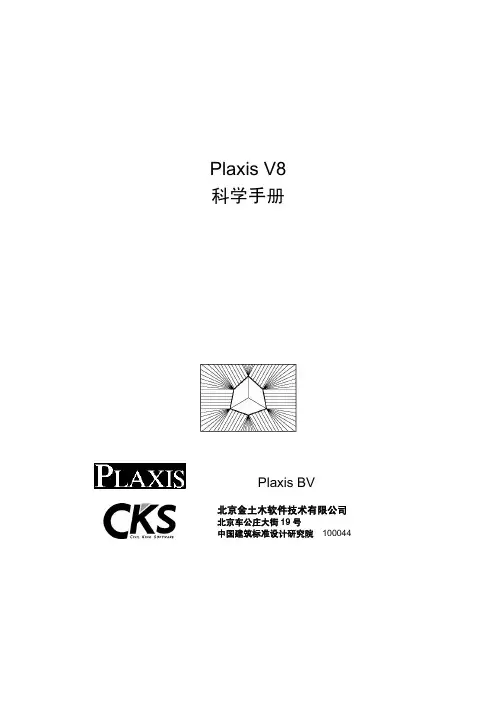
![plaxis注意点[新版]](https://uimg.taocdn.com/96cfcb0b58eef8c75fbfc77da26925c52cc59195.webp)
Plaxis注意点一.输入前说明1. 在平面应变分析里,由指定位移计算所得的力,是平面外单位长度上的力(z 方向,见图)。
轴对称分析计算所得的力(力-X,力-Y),是作用于对角弧度为1的圆弧边界上的力。
因而,要得到与整个问题对应的力,这些分力应当乘以因子2π。
轴对称分析问题的其他计算结果,是按单位宽度而不是按单位弧度给出的。
在所有输出数据里,压应力(包括孔隙压力)和压力设为负值,而拉应力和拉力设为正值。
二.输入前处理1. 平面应变模型,适用于断面(大致)均匀的几何形状,其中垂直于断面(z-方向)一定长度上的应力状态和加载机制是相同的。
z 轴方向上的位移和应变设为零。
但是,完全考虑了z 轴正应力。
轴对称模型,适用于径向断面(大致)均匀的圆形结构,加载机制围绕中心轴,设沿任意径向的变形和应力状态一致。
注意:轴对称问题的x坐标表示半径,y 坐标对应于对称轴线。
不能使用负x 坐标值。
选择平面应变或轴对称,意味着二维有限元模型的每个节点,只具备2个平移自由度(即x-和y-方向)。
2. 板用来模拟地层中的细长形结构对象,具有相当的抗弯刚度(或弯曲刚度)和轴向刚度。
板可以模拟沿z方向延伸的挡土墙、板、壳体或衬砌的影响。
最重要的参数是抗弯刚度(弯曲刚度)EI 和轴向刚度EA。
由以上两个参数可以用下式计算出板的等效厚度deq :3. 土工格栅是具有轴向刚度而无弯曲刚度的细长形结构。
土工格栅只能承受拉力,不能承受压力。
该类对象一般用来模拟土体的加固作用。
和点对点锚杆相组合的土工格栅,可以用来模拟地层锚杆。
在这种组合情况下,土工格栅用来模拟锚杆的锚固段,而点对点锚杆用来模拟锚杆的自由段。
4. 用界面单元可以研究结构对象(挡土墙、板、土工格栅等)和周围土体之间充分的相互作用。
可以使用一个加号(+)或减号(-),来标注沿同一条几何线上可能出现的两个界面。
这里的加减号仅仅是为了区别不同界面,并没有什么物理意义,对计算结果也无影响。
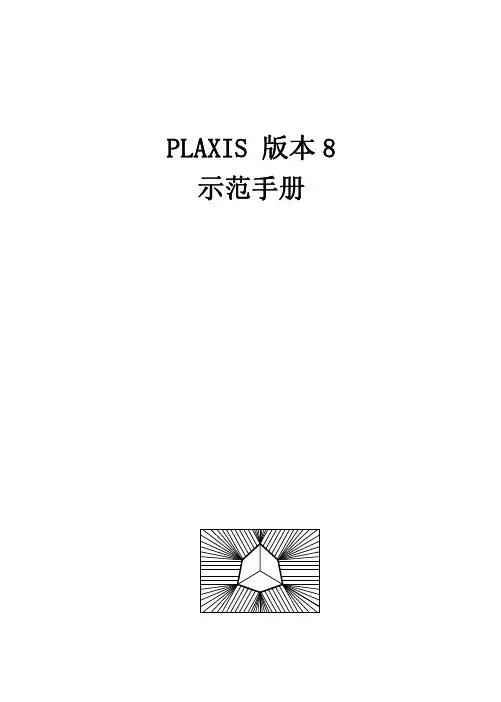
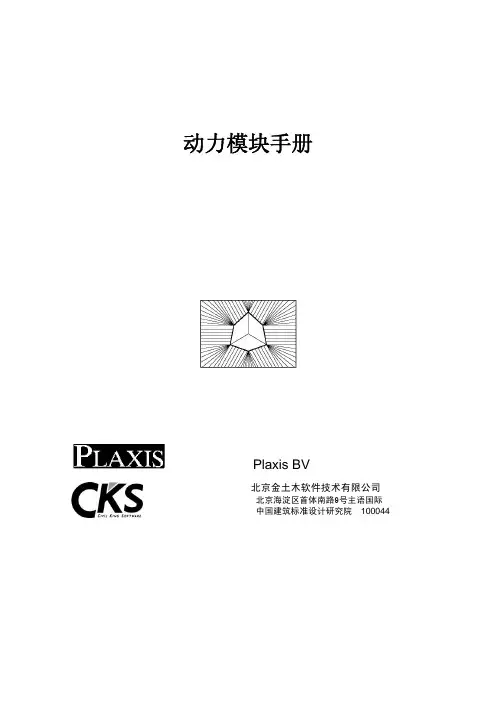
动力模块手册Plaxis BV北京金土木软件技术有限公司北京海淀区首体南路9号主语国际中国建筑标准设计研究院 100044目 录1 简介 (1)1.1关于手册 (1)1.2 V8版本动力荷载特性 (1)2、指导 (3)2.1 弹性地基上振动装置振动分析 (3)2.1.1输入 (3)2.1.2 初始条件 (5)2.1.3 计算 (6)2.1.4 输出 (7)2.2 打桩 (9)2.2.1 初始条件 (11)2.2.2计算 (11)2.2.3输出 (13)2.3 建筑物经受地震 (14)2.3.1 初始条件 (16)2.3.2 计算 (16)2.3.3 输出 (17)3参考手册 (19)3.1输入 (19)3.1.1一般设置 (20)3.1.2荷载和边界条件 (20)3.1.3吸收边界 (21)3.1.4外部荷载和指定位移 (21)3.1.5模型参数 (22)3.2计算 (24)3.2.1选择动力分析 (24)3.2.2动力分析参数 (24)3.2.3迭代过程手动设置 (25)3.2.4动力荷载 (26)3.2.5激活动力荷载 (27)3.2.6简谐荷载 (27)3.2.7数据文件中的荷载乘子时间数列 (28)3.2.8模型基本荷载 (30)3.3输出 (30)3.4曲线 (31)4 动力模块的校验 (33)4.1单向波的传播 (33)4.2简支梁 (35)4.3雷利波速的确定 (37)4.4LAMB的问题 (38)4.5表面波:与边界元的对比 (41)4.6施加在多层系统上的脉冲荷载:与波谱单元比较 (43)5理论 (46)5.1动力特性的基本方程 (46)5.2时间积分 (47)5.2.1波速 (48)5.2.2临界时间步 (48)5.3模型边界 (48)5.3.1吸收边界 (49)5.4初始应力和应力增量 (49)6 参考文献 (51)1 简介土体与结构不仅承受地表建筑物的静荷载,通常还会承受动力荷载。
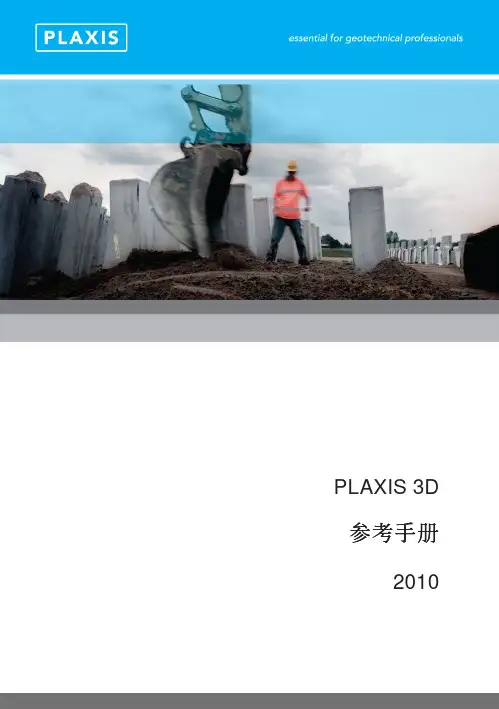
1 问:Geo FEM, Plaxis, Z-Soil软件比较2008/6/5 9:34:48答:三者针对某个算例计算结果相差不大,误差在可接受范围之内。
就易用性来说,Plaxis好于Z-Soil好于GEO。
Plaxis大家都用得很多了,Z-Soil的建模可以在前处理模块中用CAD元素绘制,或者通过dxf文件导入;GEO4只能输入剖面线的坐标,比较烦琐。
Plaxis和Z-soil基本可以解决岩土工程所有问题,但GEO4由于建模功能的限制,只能解决隧道、边坡等相关问题;Plaxis和Z-Soil可以进行渗流分析(非饱和)包括流固偶合分析。
总的来说,Plaxis和Z-Soil是专业的岩土工程有限元程序;GEO FEM是GEO4里面的一个工具包,而GEO4类似于国内的理正一样,是遵循Eurocode的设计软件。
2问:在plaxis中,用折减系数作出它的几个滑裂面,如何查看滑裂面的角度、圆心、半径等这些滑裂面的相关参数呢2008/6/59:36:26答:使用强度折减法,不用假定slip surface,故不会有这些数据。
3问:Plaxis怎么模拟路堤分步填筑在实际施工中,填筑不是一次加载的,可能先填一半,过个月再填一半,而且这一半也不是一次填完,要在几天内完成,请问怎么在Plaxis中模拟,怎么设置可以反应填筑速率,请高手指教2008/6/59:47:25答:手册里有相关例子,你可以参考一下lesson 5。
堆载速率可以通过设置堆载这个stage的时间间隔来设置。
如果只有基本模块,可以设置mstage的数值。
mstage=,说明100%施加上去了,mstage=,说明只有10%的荷载。
由于Plaxis不能设置load function,比较麻烦。
当然,你可以将一层土细分成几个stage完成,也可以实现。
4问:Plaxis 3D 用这个软件分析基坑时,基坑是钢格栅喷混凝土支护,支护用板来模拟,EI和EA中的I和A分别指哪个面的惯性矩和面积,以及单位后面的/m应该是哪个长度2008/6/59:49:13答:应该是: A=沿着洞轴方向L×厚度d E是弹性模量 I是惯性矩5问:在网上看到有人怀疑Plaxis 3D Foundation和3D Tunnel的真三维性,有人说它们不是真正的三维计算,有谁知道是怎么回事吗2008/6/59:59:42答:Plaxis 3D Tunnel计算内核是三维的。
Plaxis Version 8校验手册Plaxis BV北京金土木软件技术有限公司北京车公庄大街19号中国建筑标准设计研究院 100044目录1 绪论 (1)2已知理论解的弹性问题 (2)2.1 弹性土上的光滑刚性条形基础 (2)2.2 条形荷载下的吉布森弹性土 (3)2.3 梁的弯曲 (4)2.4 板的弯曲 (5)2.6 考虑网格更新的悬臂构件分析 (8)3 理论破坏荷载下的塑性问题 (10)3.1 圆形基础承载能力 (10)3.2条形基础的承载能力 (11)3.3 用于测试界面的滑块模型 (13)3.4 圆孔的扩孔 (14)4 固结与地下水渗流 (17)4.1 一维固结 (17)4.2 通过沙层的自由渗流 (18)4.3 隔水墙下的渗流 (20)5 参考文献 (22)1 绪论通过与解析解的仔细对比和校验,Plaxis的性能与精确性已得到验证。
第二章至第四章将有选择的阐述一些基准分析。
作为精确度和性能的附加验证,Plaxis已经对整体结构性能进行了预算与验算。
弹性基准问题:有许多已知精确解析解的问题可用来作为基准问题。
弹性计算的选择将在第二章中讲述;所选用的特定分析案例,都类似于Plaxis可能遇到的实际工程问题。
塑性基准问题:第三章将讲述关于塑性材料特性的塑性基准问题。
它们包括破坏荷载计算和滑动分析。
至于弹性基准问题,只考虑已知精确解。
地下渗流与固结:第四章将讲述关于地下水渗流基准问题,这些问题验证了地下水渗流和固结计算的正确性。
这一章也包含一些固结分析的校验例题。
个案研究:Plaxis已经广泛地应用于全尺寸岩土工程的预测和验算。
如果输入的土体模型参数和结构元件的参数是合理的,这类计算可用于进一步验证Plaxis的性能。
一些这样的工程项目可在官方网站和Plaxis 报告出版物获得。
更多模型标准数据的验证实例和对照,尤其是高级土体模型的应用,可参考材料模型手册的第九章。
2已知理论解的弹性问题本章将讲述几个弹性基准问题。
Plaxis Version 8校验手册Plaxis BV北京金土木软件技术有限公司北京车公庄大街19号中国建筑标准设计研究院 100044目录1 绪论 (1)2已知理论解的弹性问题 (2)2.1 弹性土上的光滑刚性条形基础 (2)2.2 条形荷载下的吉布森弹性土 (3)2.3 梁的弯曲 (4)2.4 板的弯曲 (5)2.6 考虑网格更新的悬臂构件分析 (8)3 理论破坏荷载下的塑性问题 (10)3.1 圆形基础承载能力 (10)3.2条形基础的承载能力 (11)3.3 用于测试界面的滑块模型 (13)3.4 圆孔的扩孔 (14)4 固结与地下水渗流 (17)4.1 一维固结 (17)4.2 通过沙层的自由渗流 (18)4.3 隔水墙下的渗流 (20)5 参考文献 (22)1 绪论通过与解析解的仔细对比和校验,Plaxis的性能与精确性已得到验证。
第二章至第四章将有选择的阐述一些基准分析。
作为精确度和性能的附加验证,Plaxis已经对整体结构性能进行了预算与验算。
弹性基准问题:有许多已知精确解析解的问题可用来作为基准问题。
弹性计算的选择将在第二章中讲述;所选用的特定分析案例,都类似于Plaxis可能遇到的实际工程问题。
塑性基准问题:第三章将讲述关于塑性材料特性的塑性基准问题。
它们包括破坏荷载计算和滑动分析。
至于弹性基准问题,只考虑已知精确解。
地下渗流与固结:第四章将讲述关于地下水渗流基准问题,这些问题验证了地下水渗流和固结计算的正确性。
这一章也包含一些固结分析的校验例题。
个案研究:Plaxis已经广泛地应用于全尺寸岩土工程的预测和验算。
如果输入的土体模型参数和结构元件的参数是合理的,这类计算可用于进一步验证Plaxis的性能。
一些这样的工程项目可在官方网站和Plaxis 报告出版物获得。
更多模型标准数据的验证实例和对照,尤其是高级土体模型的应用,可参考材料模型手册的第九章。
2已知理论解的弹性问题本章将讲述几个弹性基准问题。
P LAXIS 3D T UNNEL Material ModelsManualversion 2TABLE OF CONTENTS TABLE OF CONTENTS1Introduction..................................................................................................1-11.1On the use of different models...............................................................1-11.2Limitations.............................................................................................1-2 2Preliminaries on material modelling..........................................................2-12.1General definitions of stress...................................................................2-12.2General definitions of strain...................................................................2-32.3Elastic strains.........................................................................................2-52.4Undrained analysis with effective parameters.......................................2-72.5Undrained analysis with undrained parameters...................................2-102.6The initial preconsolidation stress in advanced models.......................2-112.7On the initial stresses...........................................................................2-12 3The Mohr-Coulomb model (perfect-plasticity)........................................3-13.1Elastic perfectly-plastic behaviour.........................................................3-13.2Formulation of the Mohr-Coulomb model.............................................3-33.3Basic parameters of the Mohr-Coulomb model.....................................3-53.4Advanced parameters of the Mohr-Coulomb model..............................3-8 4The Jointed Rock model (anisotropy).......................................................4-14.1Anisotropic elastic material stiffness matrix..........................................4-24.2Plastic behaviour in three directions......................................................4-44.3Parameters of the Jointed Rock model...................................................4-7 5The Hardening-Soil model (isotropic hardening)....................................5-15.1Hyperbolic relationship for standard drained triaxial test......................5-25.2Approximation of hyperbola by the Hardening-Soil model...................5-35.3Plastic volumetric strain for triaxial states of stress...............................5-55.4Parameters of the Hardening-Soil model...............................................5-65.5On the cap yield surface in the Hardening-Soil model........................5-10 6Soft-Soil-Creep model (time dependent behaviour).................................6-16.1Introduction............................................................................................6-16.2Basics of one-dimensional creep............................................................6-26.3On the variables τc and εc.......................................................................6-46.4Differential law for 1D-creep.................................................................6-66.5Three-dimensional-model......................................................................6-86.6Formulation of elastic 3D-strains.........................................................6-106.7Review of model parameters................................................................6-116.8Validation of the 3D-model.................................................................6-14iMATERIAL MODELS MANUAL7Applications of advanced soil models.........................................................7-17.1Modelling simple soil tests....................................................................7-17.1.1Oedometer test...........................................................................7-17.1.2Standard triaxial test..................................................................7-27.2HS model: response in drained and undrained triaxial tests..................7-47.3Application of the Hardening-Soil model on real soil tests...................7-77.4SSC model: response in one-dimensional compression test................7-127.5Jointed Rock model: failure at different sliding directions..................7-15 8References....................................................................................................8-1 Appendix A – Symbolsii P LAXIS 3D T UNNELINTRODUCTION 1INTRODUCTIONThe mechanical behaviour of soils may be modelled at various degrees of accuracy. Hooke's law of linear, isotropic elasticity, for example, may be thought of as the simplest available stress-strain relationship. As it involves only two input parameters, i.e. Young's modulus, E, and Poisson's ratio, ν, it is generally too crude to capture essential features of soil and rock behaviour. For modelling massive structural elements and bedrock layers, however, linear elasticity tends to be appropriate.1.1ON THE USE OF DIFFERENT MODELSMohr-Coulomb model (MC)The elastic-plastic Mohr-Coulomb model involves five input parameters, i.e. E and ν for soil elasticity; φand c for soil plasticity and ψ as an angle of dilatancy. This Mohr-Coulomb model represents a 'first-order' approximation of soil or rock behaviour. It is recommended to use this model for a first analysis of the problem considered. For each layer one estimates a constant average stiffness. Due to this constant stiffness, computations tend to be relatively fast and one obtains a first impression of deformations. Besides the five model parameters mentioned above, initial soil conditions play an essential role in most soil deformation problems. Initial horizontal soil stresses have to be generated by selecting proper K0-values.Jointed Rock model (JR)The Jointed Rock model is an anisotropic elastic-plastic model, especially meant to simulate the behaviour of rock layers involving a stratification and particular fault directions. Plasticity can only occur in a maximum of three shear directions (shear planes). Each plane has its own strength parameters φand c. The intact rock is considered to behave fully elastic with constant stiffness properties E and ν. Reduced elastic properties may be defined for the stratification direction.Hardening-Soil model (HS)The Hardening-Soil model is an advanced model for the simulation of soil behaviour. As for the Mohr-Coulomb model, limiting states of stress are described by means of the friction angle, φ, the cohesion, c, and the dilatancy angle, ψ. However, soil stiffness is described much more accurately by using three different input stiffnesses: the triaxial loading stiffness, E50, the triaxial unloading stiffness, E ur, and the oedometer loading stiffness, E oed. As average values for various soil types, we have E ur≈ 3 E50 and E oed≈E50, but both very soft and very stiff soils tend to give other ratios of E oed / E50.In contrast to the Mohr-Coulomb model, the Hardening-Soil model also accounts for stress-dependency of stiffness moduli. This means that all stiffnesses increase with pressure. Hence, all three input stiffnesses relate to a reference stress, being usually taken as 100 kPa (1 bar).1-1MATERIAL MODELS MANUALSoft-Soil-Creep model (SSC)The above Hardening-Soil model is suitable for all soils, but it does not account for viscous effects, i.e. creep and stress relaxation. In fact, all soils exhibit some creep and primary compression is thus followed by a certain amount of secondary compression. The latter is most dominant in soft soils, i.e. normally consolidated clays, silts and peat, and we thus implemented a model under the name Soft-Soil-Creep model. Please note that the Soft-Soil-Creep model is a relatively new model that has been developed for application to settlement problems of foundations, embankments, etc. For unloading problems, as normally encountered in tunnelling and other excavation problems, the Soft-Soil-Creep model hardly supersedes the simple Mohr-Coulomb model. As for the Mohr-Coulomb model, proper initial soil conditions are also essential when using the Soft-Soil-Creep model. For the Hardening-Soil model and the Soft-Soil-Creep model this also includes data on the preconsolidation stress, as these models account for the effect of overconsolidation.Analyses with different modelsIt is advised to use the Mohr-Coulomb model for a relatively quick and simple first analysis of the problem considered. When good soil data is lacking, there is no use in further more advanced analyses.In many cases, one has good data on dominant soil layers, and it is appropriate to use the Hardening-Soil model in an additional analysis. No doubt, one seldomly has test results from both triaxial and oedometer tests, but good quality data from one type of test can be supplemented by data from correlations and/or in situ testing.Finally, a Soft-Soil-Creep analysis can be performed to estimate creep, i.e. secondary compression in very soft soils. The above idea of analysing geotechnical problems with different soil models may seem costly, but it tends to pay off. First of all due to the fact that the Mohr-Coulomb analysis is relatively quick and simple and secondly as the procedure tends to reduce errors.1.2LIMITATIONSThe P LAXIS code and its soil models have been developed to perform calculations of realistic geotechnical problems. In this respect P LAXIS can be considered as a geotechnical simulation tool. The soil models can be regarded as a qualitative representation of soil behaviour whereas the model parameters are used to quantify the soil behaviour. Although much care has been taken for the development of the P LAXIS code and its soil models, the simulation of reality remains an approximation, which implicitly involves some inevitable numerical and modelling errors. Moreover, the accuracy at which reality is approximated depends highly on the expertise of the user regarding the modelling of the problem, the understanding of the soil models and their limitations, the selection of model parameters, and the ability to judge the reliability of the computational results.1-2 P LAXIS 3D T UNNELINTRODUCTION Both the soil models and the P LAXIS code are constantly being improved such that each new version is an update of the previous ones. Some of the present limitations are listed below:HS-modelIt is a hardening model that does not account for softening due to soil dilatancy and de-bonding effects. In fact, it is an isotropic hardening model so that it models neither hysteresis and cyclic loading nor cyclic mobility. In order to model cyclic loading with good accuracy one would need a more complex model. Last but not least, the use of the Hardening Soil model generally results in significantly longer calculation times, since the material stiffness matrix is formed and decomposeed in each calculation step.SSC-modelAll above limitations also hold true for the Soft-Soil-Creep model. In addition this model tends to overpredict the range of elastic soil behaviour. This is especially the case for excavation problems, including tunnelling.InterfacesInterface elements are generally modelled by means of the bilinear Mohr-Coulomb model. When a more advanced model is used for the corresponding cluster material data set, the interface element will only pick up the relevant data (c, φ, ψ, E, ν) for the Mohr-Coulomb model, as described in Section 3.5.2 of the Reference Manual. In such cases the interface stiffness is taken to be the elastic soil stiffness. Hence, E = E ur where E ur is stress level dependent, following a power law with E ur proportional to σm. For the Soft-Soil-Creep model, the power m is equal to 1 and E ur is largely determined by the swelling constant κ*.1-3MATERIAL MODELS MANUAL1-4 P LAXIS 3D T UNNELPRELIMINARIES ON MATERIAL MODELLING 2-12 PRELIMINARIES ON MATERIAL MODELLINGA material model is a set of mathematical equations that describes the relationshipbetween stress and strain. Material models are often expressed in a form in whichinfinitesimal increments of stress (or 'stress rates') are related to infinitesimal incrementsof strain (or 'strain rates'). All material models implemented in the P LAXIS 3D Tunnel program are based on a relationship between the effective stress rates, ’σ&, and the strain rates, ε&. In the following section it is described how stresses and strains are defined inP LAXIS . In subsequent sections the basic stress-strain relationship is formulated and theinfluence of pore pressures in undrained materials is described. Later sections focus oninitial conditions for advanced material models.2.1 GENERAL DEFINITIONS OF STRESSStress is a tensorial quantity which can be represented by a matrix with Cartesian components:xx xy xz yxyy yz zx zy zz σσσσσσσσσσ⎡⎤⎢⎥=⎢⎥⎢⎥⎣⎦(2.1) In the standard deformation theory, the stress tensor is symmetric, so σxy = σyx , σyz = σzyand σzx = σxz . In this situation, stresses are often written in vector notation, which involve only six different components:()T xx yy zz xy yz zx σσσσσσσ= (2.2) According to Terzaghi's principle, stresses in the soil are divided into effective stresses, σ', and pore pressures, σ w :'w σσσ=+ (2.3) Water is considered not to sustain any shear stresses. As a result, effective shear stressesare equal to total shear stresses. Positive normal stress components are considered torepresent tension, whereas negative normal stress components indicate pressure (orcompression).Material models for soil and rock are generally expressed as a relationship betweeninfinitesimal increments of effective stress and infinitesimal increments of strain. Insuch a relationship, infinitesimal increments of effective stress are represented by stress rates (with a dot above the stress symbol):()''''T xx yy zz xy yz zx σσσσσσσ=&&&&&&& (2.4)MATERIAL MODELS MANUAL2-2 P LAXIS 3D T UNNELxx σzzxzFigure 2.1 General three-dimensional coordinate system and sign convention for stressesIt is often useful to use principal stresses rather than Cartesian stress components whenformulating material models. Principal stresses are the stresses in such a coordinatesystem direction that all shear stress components are zero. Principal stresses are, in fact,the eigenvalues of the stress tensor. Principal effective stresses can be determined in the following way:()''0Det I σσ−= (2.5) where I is the identity matrix. This equation gives three solutions for σ', i.e. the principaleffective stresses (σ'1, σ'2, σ'3). In P LAXIS the principal effective stresses are arranged inalgebraic order: 123σσσ≤≤′′′ (2.6) Hence, σ'1 is the largest compressive principal stress and σ'3 is the smallest compressiveprincipal stress. In this manual, models are often presented with reference to theprincipal stress space, as indicated in Figure 2.2.Figure 2.2 Principal stress space-σ'3-σ'2σ'3In addition to principal stresses it is also useful to define invariants of stress, which arestress measures that are independent of the orientation of the coordinate system. Twouseful stress invariants are:p' = ()13'''xx yy zz -σσσ++ (2.7a)q = (2.7b)where p ' is the isotropic effective stress, or mean effective stress, and q is the equivalentshear stress. Note that the convention adopted for p ' is positive for compression incontrast to other stress measures. The equivalent shear stress, q , has the importantproperty that it reduces to q = │σ1'-σ3'│ for triaxial stress states with σ2' = σ3'.Principal stresses can be written in terms of the invariants:()22133''sin p q σθπ−=+− (2.8a)()223''sin p q σθ−=+ (2.8b) ()22333''sin p q σθπ−=++ (2.8c) in which θ is referred to as Lode's angle (a third invariant), which is defined as:313327arcsin 2J q θ⎛⎞=⎜⎝⎠(2.9) with ()()()()()()2223''''''''''''2xx yy zz xx yz yy zx zz xy xy yz zx J -p -p -p -p -p -p σσσσσσσσσσσσ=−−−+(2.10)2.2 GENERAL DEFINITIONS OF STRAIN Strain is a tensorial quantity which can be represented by a matrix with Cartesiancomponents:xx xy xz yxyy yz zx zy zz εεεεεεεεεε⎡⎤⎢⎥=⎢⎥⎢⎥⎣⎦(2.11)Strains are the derivatives of the displacement components, i.e. εij = ∂u i / ∂j , where i andj are either x , y or z . According to the small deformation theory, only the sum ofcomplementing Cartesian shear strain components εij and εji results in shear stress. Thissum is denoted as the shear strain γ. Hence, instead of εxy , εyx , εyz , εzy , εzx and εxz theshear strain components γxy , γyz and γzx are used respectively. Under the aboveconditions, strains are often written in vector notation, which involve only six different components:()T xx yy zz xy yz zx εεεεγγγ= (2.12)x xx u x ε∂=∂ (2.13a) yyy u y ε∂=∂ (2.13b) z zz u zε∂=∂ (2.13c) y x xy xy yx u u y x γεε∂∂=+=+∂∂ (2.13d) y z yz yz zy u u z y γεε∂∂=+=+∂∂ (2.13e) x z zx zx xz u u x zγεε∂∂=+=+∂∂ (2.13f) Similarly as for stresses, positive normal strain components refer to extension, whereasnegative normal strain components indicate compression.In the formulation of material models, where infinitesimal increments of strain areconsidered, these increments are represented by strain rates (with a dot above the strain symbol).()T xx yy zz xy yz zx γγγεεεε=&&&&&&& (2.14)In analogy to the invariants of stress, it is also useful to define invariants of strain. Astrain invariant that is often used is the volumetric strain, εν, which is defined as the sumof all normal strain components:123v xx yy zz εεεεεεε=++=++ (2.15) The volumetric strain is defined as negative for compaction and as positive fordilatancy.For elastoplastic models, as used the P LAXIS 3D Tunnel program, strains are decomposed into elastic and plastic components:e p εεε=+ (2.16) Throughout this manual, the superscript e will be used to denote elastic strains and thesuperscript p will be used to denote plastic strains.2.3 ELASTIC STRAINSMaterial models for soil and rock are generally expressed as a relationship betweeninfinitesimal increments of effective stress ('effective stress rates') and infinitesimal increments of strain ('strain rates'). This relationship may be expressed in the form:M σε=′&& (2.17) M is a material stiffness matrix. Note that in this type of approach, pore-pressures areThe simplest material model in the 3D Tunnel program is Hooke's law for isotropiclinear elastic behaviour. This model is available in the Plaxis 3D Tunnel program underthe name Linear Elastic model, but it is also the basis of other models. Hooke's law canbe given by the equation: ()()121211'''000''1''000'''1'000''000'00'12'1'0000'0'00000''xx xx yy yy zz zz xy xy yz yz zx zx εεεE γγγνννσνννσνννσνσνννσνσ−⎡⎤⎡⎤⎡⎤⎢⎥⎢⎥⎢⎥−⎢⎥⎢⎥⎢⎥⎢⎥⎢⎥⎢⎥−=⎢⎥⎢⎥⎢⎥−−+⎢⎥⎢⎥⎢⎥⎢⎥⎢⎥⎢⎥−⎢⎥⎢⎥⎢⎥−⎢⎥⎢⎥⎢⎥⎣⎦⎣⎦⎣⎦&&&&&&&&&&&& (2.18) The elastic material stiffness matrix is often denoted as D e . Two parameters are used inthis model, the effective Young's modulus, E ν'. In theremaining part of this manual effective parameters are denoted without dash ('), unless adifferent meaning is explicitly stated. The symbols E and ν are sometimes used in thismanual in combination with the subscript ur to emphasize that the parameter isexplicitly meant for unloading and reloading. A stiffness modulus may also be indicatedwith the subscript ref to emphasize that it refers to a particular reference level (y ref ) (seefurther).The relationship between Young's modulus E and other stiffness moduli, such as theshear modulus G , the bulk modulus K , and the oedometer modulus E oed , is given by:()21E G ν=+ (2.19a) ()312E K ν=− (2.19b) ()()()1121oed - E E ννν=−+ (2.19c) During the input of material parameters for the Linear Elastic model or the Mohr-Coulomb model the values of G and E oed are presented as auxiliary parameters(alternatives), calculated from Eq. (2.19). Note that the alternatives are influenced by theinput values of E and ν. Entering a particular value for one of the alternatives G or E oedresults in a change of the E modulus.Figure 2.3 Parameters tab for the Linear Elastic modelIt is possible for the Linear Elastic model to specify a stiffness that varies linearly withdepth. This can be done by entering the advanced parameters window using theAdvanced button, as shown in Figure 2.3. Here one may enter a value for E increment whichis the increment of stiffness per unit of depth, as indicated in Figure 2.4.Figure 2.4 Advanced parameter windowTogether with the input of E increment the input of y ref becomes relevant. Above y ref thestiffness is equal to E ref . Below the stiffness is given by:() actual ref ref increment ref E E y y E y y =+−< (2.20)The Linear Elastic model is usually inappropriate to model the highly non-linearbehaviour of soil, but it is of interest to simulate structural behaviour, such as thickconcrete walls or plates, for which strength properties are usually very high comparedwith those of soil. For these applications, the Linear Elastic model will often be selectedtogether with Non-porous type of material behaviour in order to exclude pore pressuresfrom these structural elements.2.4 UNDRAINED ANALYSIS WITH EFFECTIVE PARAMETERSIn the P LAXIS 3D Tunnel program it is possible to specify undrained behaviour in aneffective stress analysis using effective model parameters. This is achieved byidentifying the Type of material behaviour (Material type ) of a soil layer as Undrained .In this Section, it is explained how P LAXIS deals with this special option. The presenceof pore pressures in a soil body, usually caused by water, contributes to the total stresslevel. According to Terzaghi's principle, total stresses σ can be divided into effectivestresses σ' and pore pressures σw (see also Eq. 2.3). However, water is supposed not tosustain any shear stress, and therefore the effective shear stresses are equal to the totalshear stresses:'xx xx w σσσ=+ (2.21a) 'yy yy w σσσ=+ (2.21b) 'zz zz w σσσ=+ (2.21c) 'xy xy σσ= (2.21d) 'yz yz σσ= (2.21e) 'zx zx σσ= (2.21f)Note that, similar to the total and the effective stress components, σw is considerednegative for pressure.A further distinction is made between steady state pore stress, p steady , and excess porestress, p excess :w steady excess p p σ=+ (2.22)Steady state pore pressures are considered to be input data, i.e. generated on the basis ofphreatic levels. This generation of steady state pore pressures is discussed in Section 3.8of the Reference Manual. Excess pore pressures are generated during plastic calculationsfor the case of undrained material behaviour. Undrained material behaviour and thecorresponding calculation of excess pore pressures is described below.Since the time derivative of the steady state component equals zero, it follows:w excess p σ=&& (2.23) Hooke's law can be inverted to obtain:'1''000''1'000'''1000100022'00'000022'00000022'e xx xx e yy yy e zz zz e xy xy e yz yz e zx zx E σννεσννεσννεσνγσνγσνγ−−⎡⎤⎡⎤⎡⎤⎢⎥⎢⎥⎢⎥−−⎢⎥⎢⎥⎢⎥⎢⎥⎢⎥⎢⎥−−=⎢⎥⎢⎥⎢⎥+⎢⎥⎢⎥⎢⎥⎢⎥⎢⎥⎢⎥+⎢⎥⎢⎥⎢⎥+⎢⎥⎢⎥⎢⎥⎣⎦⎣⎦⎣⎦&&&&&&&&&&&& (2.24) Substituting Eq. (2.21) gives:1''000'1'000''1000100022'00'000022'00000022'e xx w xx e yy w yy e zz w zz e xy xy e yz yz e zx zx E σσννεσσννεσσννεσνγσνγσνγ−−−⎡⎤⎡⎤⎡⎤⎢⎥⎢⎥⎢⎥−−−⎢⎥⎢⎥⎢⎥⎢⎥⎢⎥⎢⎥−−−=⎢⎥⎢⎥⎢⎥+⎢⎥⎢⎥⎢⎥⎢⎥⎢⎥⎢⎥+⎢⎥⎢⎥⎢⎥+⎢⎥⎢⎥⎢⎥⎣⎦⎣⎦⎣⎦&&&&&&&&&&&&&&& (2.25) Considering slightly compressible water, the rate of pore pressure is written as:()w e e e xx yy zz w K + + nσεεε=&&&& (2.26) in which K w is the bulk modulus of the water and n is the soil porosity.The inverted form of Hooke's law may be written in terms of the total stress rates andthe undrained parameters E u and νu :1000'1000'1000'1000220000002200000022e u u xx xx e u u yy yy e u u zz zz e u xy u xy e u yz yz e u zx zx E ννσεννσεννσενσγνσγνσγ−−⎡⎤⎡⎤⎡⎤⎢⎥⎢⎥⎢⎥−−⎢⎥⎢⎥⎢⎥⎢⎥⎢⎥⎢⎥−−=⎢⎥⎢⎥⎢⎥+⎢⎥⎢⎥⎢⎥⎢⎥⎢⎥⎢⎥+⎢⎥⎢⎥⎢⎥+⎢⎥⎢⎥⎢⎥⎣⎦⎣⎦⎣⎦&&&&&&&&&&&& (2.27) where: ()21u u EG + ν=()()'1'121'u νµννµν++=++ (2.28) µ = 13'w Kn K ()'312E K ν=′−′ (2.29) Hence, the special option for undrained behaviour in P LAXIS is such that the effectiveparameters G and ν are transferred into undrained parameters E u and νu according to Eq.(2.28) and (2.29). Note that the index u is used to indicate auxiliary parameters forundrained soil. Hence, E u and νu should not be confused with E ur and νur as used todenote unloading / reloading.Fully incompressible behaviour is obtained for νu = 0.5. However, taking νu = 0.5 leadsto singularity of the stiffness matrix. In fact, water is not fully incompressible, but arealistic bulk modulus for water is very large. In order to avoid numerical problemscaused by an extremely low compressibility, νu is taken as 0.495, which makes theundrained soil body slightly compressible. In order to ensure realistic computationalresults, the bulk modulus of the water must be high compared with the bulk modulus ofthe soil skeleton, i.e. K w >>n K '. This condition is sufficiently ensured by requiring ν' ≤0.35. Users will get a warning as soon as larger Poisson's ratios are used in combinationwith undrained material behaviour.Consequently, for undrained material behaviour a bulk modulus for water is automatically added to the stiffness matrix. The value of the bulk modulus is given by:()()()30.495300301121u w u K K K K n νννννν−′−′==>′′′+′−+′ (2.30) at least for ν' ≤ 0.35.The rate of excess pore pressure is calculated from the (small) volumetric strain rate, according to:w w v K nσε=&& (2.31) The type of elements used in the P LAXIS 3D Tunnel program are sufficiently adequate toavoid mesh locking effects for nearly incompressible materials.This special option to model undrained material behaviour on the basis of effectivemodel parameters is available for all material models in the P LAXIS 3D Tunnel program.This enables undrained calculations to be executed with effective input parameters, withexplicit distinction between effective stresses and (excess) pore pressures.Such an analysis requires effective soil parameters and is therefore highly convenientwhen such parameters are available. For soft soil projects, accurate data on effectiveparameters may not always be available. Instead, in situ tests and laboratory tests mayhave been performed to obtain undrained soil parameters. In such situations measuredundrained Young's moduli can be easily converted into effective Young's moduli by:()21'3u E E ν+=′ (2.32) Undrained shear strengths, however, cannot easily be used to determine the effectivestrength parameters φ and c . For such projects the P LAXIS 3D Tunnel program offers thepossibility of an undrained analysis with direct input of the undrained shear strength(c u or s u ) and φ = φu = 0°. This option is only available for the Mohr-Coulomb modeland the Hardening-Soil model, but not for the Soft Soil Creep model. Note thatwhenever the Material type parameter is set to Undrained , effective values must beentered for the elastic parameters E and ν!2.5 UNDRAINED ANALYSIS WITH UNDRAINED PARAMETERSIf, for any reason, it is desired not to use the Undrained option in the P LAXIS 3D Tunnelprogram to perform an undrained analysis, one may simulate undrained behaviour byselecting the Non-porous option and directly entering undrained elastic properties E = E uand ν=νu =0.495 in combination with the undrained strength properties c = c u andφ = φu = 0°. In this case a total stress analysis is performed without distinction betweeneffective stresses and pore pressures. Hence, all tabulated output referring to effectivestresses should now be interpreted as total stresses and all pore pressures are equal tozero. In graphical output of stresses the stresses in Non-porous clusters are not plotted. Ifone does want graphical output of stresses one should select Drained instead of Non-porous for the type of material behaviour and make sure that no pore pressures aregenerated in these clusters.Note that this type of approach is not possible when using the Soft Soil Creep model. Ingeneral, an effective stress analysis using the Undrained option in P LAXIS to simulateundrained behaviour is preferable over a total stress analysis.。